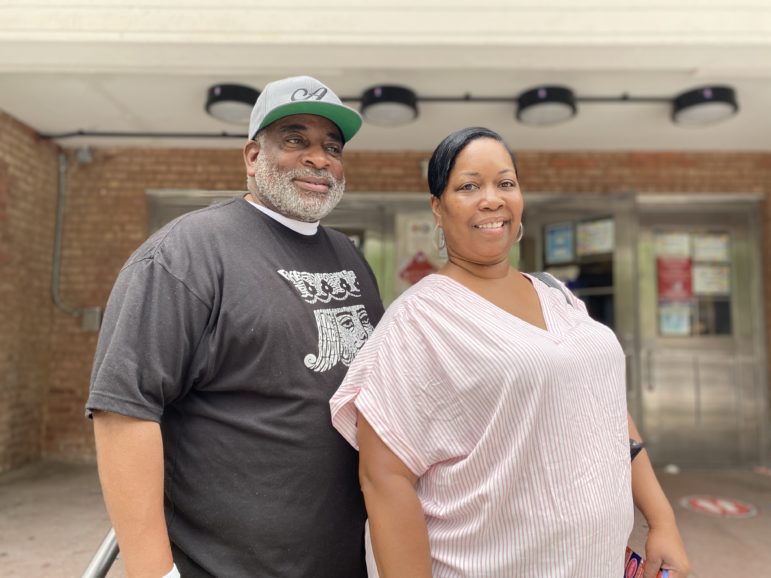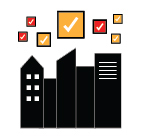‘For me it’s not about choice—I know who I want to vote for and I voted for them,’ one voter told City Limits Tuesday. But others said they like RCV, and that it prompted them do more research about the candidates than they normally would.

David Brand
Corrine and Anthony Haynes voted for Eric Adams and said they decided not to rank their ballots.Tuesday’s primary election is the first citywide use of ranked choice voting, which allows New Yorkers to choose up to five candidates in each race and rank them in order of preference. If no one wins at least 50 percent of votes in the first round, the person who received the fewest ballots is eliminated and their ballots are redistributed to the remaining ranked candidates. This process continues until just two names remain.
The method aims to address the fact that under the old way of voting, city contests with multiple candidates meant someone could win with a relatively small share of ballots—just as long as they earned more votes than their competitors. It’s also intended to avoid costly runoff elections and help cut back some of the political divisiveness elections usually create.
But not everyone is embracing the new system.
“I’m very definite on who I want to vote for. I’ve been voting since I was 18 and I’m going to be 54 in another month. So for me it’s not about choice—I know who I want to vote for and I voted for them,” said Thomas Smith, who was casting his ballot for just one candidates in the mayoral race at PS 94 in the Norwood section of the Bronx. “I don’t see the point in that. I mean, it’s a nice thought, but no, it’s a waste.”
The city spent nearly $15 million this spring on a campaign to educate voters about how ranked choice voting works, including $8 million on TV and digital ads, another $2 million on outreach partnerships and $1.1 million was spent on print ads, including on buses and subways.
But Susan Cuenca, a student who voted at M.S. 80 is along Mosholu Parkway in the Bronx, said she hadn’t heard of the new method until she showed up at the polls Tuesday morning. Still, she described the process as “pretty easy” and ended up listing five mayoral candidates on her ballot.
“It’s my first time seeing a whole new process with the five choices,” she said. “For me it was pretty easy, I understood it. You’ve just got to read the directions exactly how it says.”
Corrine and Anthony Haynes voted for Eric Adams at the poll site at the Jacob Riis Settlement House in Queensbridge. They said they decided not to rank their ballots.
“I don’t trust ranked choice voting. It’s too complicated,” said Corrine Haynes. She said she liked Ray McGuire and may have ranked him second, but she worried her ballot wouldn’t count if she only ranked two candidates. But doing so would have been allowed—Under ranked choice voting, voters can rank as many or as few candidates as they want, according to Board of Election rules.
Haynes said she hopes Adams wins and teams up with McGuire in his administration when it comes to policing and the economy. “If they worked together, the city would amazing.”
At Yorkville Community School on Manhattan’s Upper East Side, most voters who spoke to City Limits said they understood ranked choice voting and used it. Ron Tremba, who arrived at the poll site with his wife Stefka Nazarkewycz and their little white dog, Teddy, said the new method prompted them to do more research about the candidates than they normally would.
Tremba ranked former Sanitation Commissioner Kathryn Garcia first on his mayoral ballot, and said the possibility of the city getting its first female mayor was on his mind.
“It’ll be nice to have a change,” he said.
Mary Samuels, who showed up on Tuesday with her daughter to vote at P.S. 119 in the southeast Bronx, said she found the large numbers of candidates for most of the races on the ballot daunting. Democratic voters had 13 mayoral candidates to choose from, 10 options for comptroller and eight contenders running for in Samuels’ Council District 18.
Studying each candidate’s positions and platforms felt, she said, “like going back to school and going to get a diploma.”
But Sydney Kerlew, the poll coordinator at the Mott Haven Community Center in the south Bronx, thought ranked-choice voting was no more of an obstacle to folks than traditional voting is. Though even with a sample ballot at the poll site and workers who assist voters, he said, “a lot of people do make mistakes. We’re only human. No one is perfect, so it happens.”
Iris Aponte, who cast her ballot at the Betances Community Center on the Bronx, said she thought the new method was simple to understand. She filled out all of her top five choices, but she said she prefers the traditional pick one-and-done style of voting for another reason: the fact that it will likely be weeks before all absentee ballots are counted and the final votes are redistributed.
“I don’t especially care for the fact that it’s going to take so long to finally know who won,” she said.
–Adi Talwar, David Brand, Jeanmarie Evelly, Ese Olumhense, Griffin Kelly and Liz Donovan
Read more:
2021 Primary Day Thread: NYC Votes for a New Mayor, City Council
NYC Spent Nearly $15 Million to Publicize Ranked-Choice Voting. Some Say It Came Too Late.
14 NYC Council Candidates Raised $100K or More. How’d They Do It?









